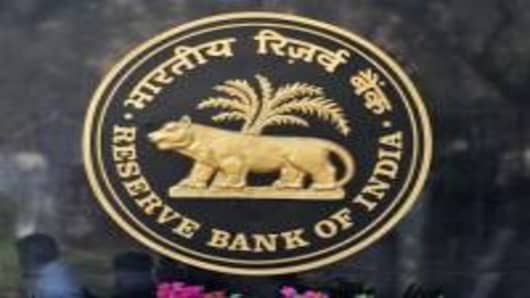Despite the recent let-up in inflationary pressures, and a big cut in growth expectations, India's central bank kept its powder dry at its monetary policy meeting on Tuesday, prompting the question - what will it take policymakers to move on interest rates?
Economists told CNBC that the Reserve Bank of India (RBI), which
kept the benchmark rate steady at 8 percent
, wants more evidence that inflation is easing.
"They need an accumulation of evidence toward disinflation before they are comfortable enough to cut rates. They need two to three months of data before they do so," Taimur Baig chief India economist at Deutsche Bank told CNBC.
India's main inflation gauge, the wholesale price index (WPI) has eased for two straight months. In November it cooled to its weakest pace in 10 months coming in at a lower-than-expected 7.24 percent from a year earlier and below October's 7.45 percent.
(Read more: India's November Inflation Lowest in 10 Months)
But economists, like Rajeev Malik of CLSA, say that the RBI needs to be convinced that inflation is headed towards their medium term guidance of around 5 percent. "This does not mean they will wait till it reaches there but there should be evidence that it is headed there," he said adding that "It's a question of timing, when will they cut and not will they cut."
The consensus is that the central bank will likely wait for one more inflation reading to confirm whether price pressures are on a sustainable downtrend and cut rates in January.
By the time RBI meets again on January 15, they would probably have seen three months of slowing inflation, and this will likely be enough to assess the trend, Baig said, noting that the December inflation numbers will be important.
(Read more: Why India's Central Bank Resisted Pressure to Ease)
Sonal Varma, India economist at Nomura, expects a total of 50 basis points in rate cuts over the first-half of 2013, starting with a 25 basis point move in January. She adds that the RBI is holding off in order to get a clearer picture of the inflation situation.
"We believe that a window for rate cuts will open in in the first half of 2013 as headline and core inflation remain in check," Varma wrote in a report.
The RBI, in its mid-year policy review also said that "in view of inflation pressures ebbing, monetary policy has to increasingly shift focus and respond to the threats to growth from this point onwards."
This statement further points to the possibility of a rate cut early next year as government lowers growth expectations to between 5.7 percent and 5.9 percent for the fiscal year ending in March 2013.
(Read more:
India Lowers Growth Forecast, on Track for Deficit
)
India's economy has been reeling under high levels of inflation this year due to a combination of supply constraints, a deficient monsoon and a weak currency – which has raised the cost of imports.
This has posed a large challenge for the central bank, which has been under pressure to reignite growth in Asia's third largest economy. It has left interest rates unchanged since April, when it last lowered borrowing costs by 50 basis points.
However, price pressures have eased with the Indian Finance Ministry saying on Monday it expects inflation to fall to 6.7-7 percent by March 2013.
Leif Eskesen, India economist at HSBC said the RBI might wait for signs that consumer price inflation has peaked as well, which could delay easing until February or March.
Consumer inflation – a reflection of price movements in household goods and services - rose to 9.9 percent in November.
"HSBC PMI (purchasing managers index) sub-indices for input and output prices also suggest that inflation pressures remain firm and that we are not out of the woods yet," Eskesen wrote.



